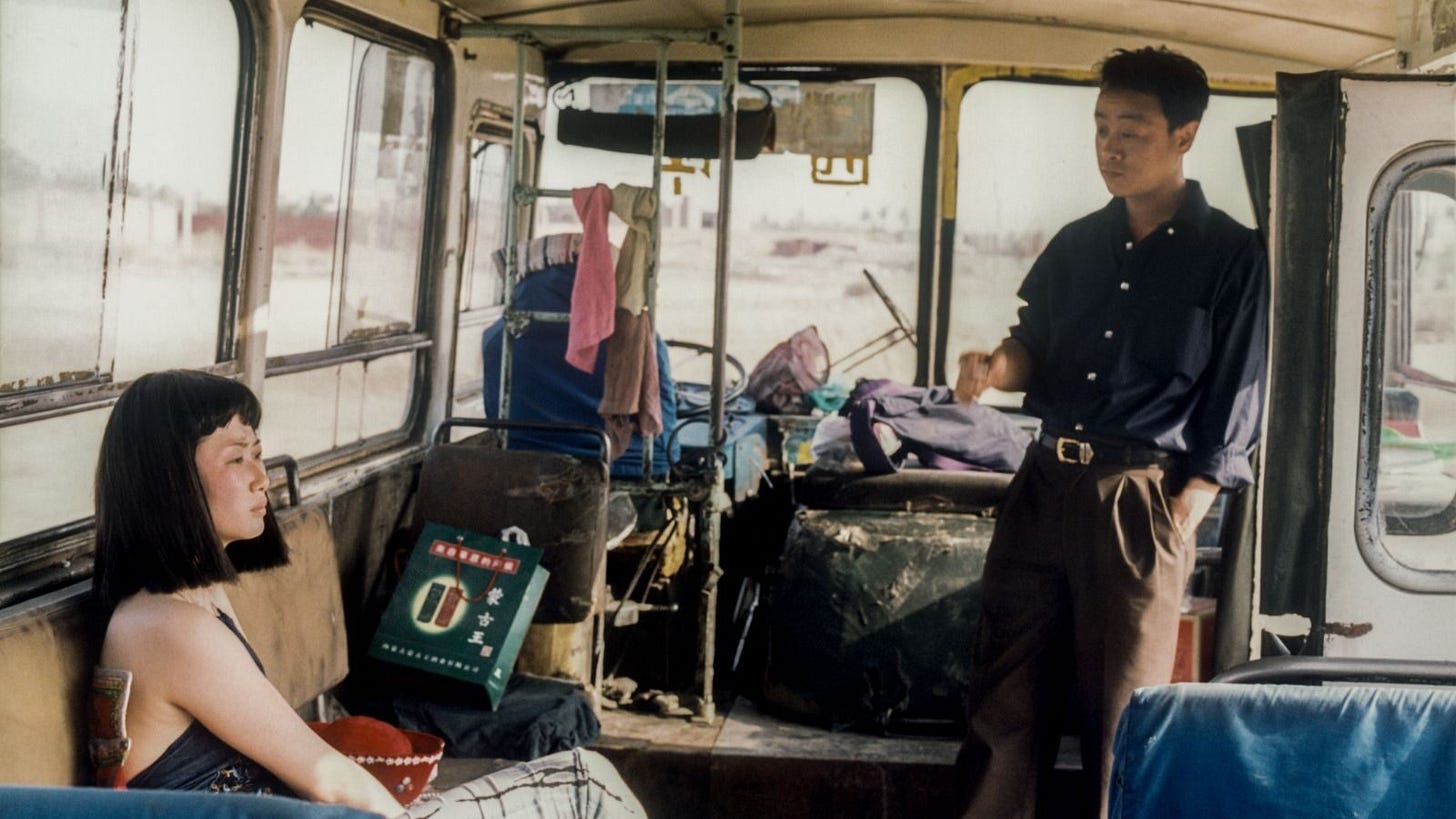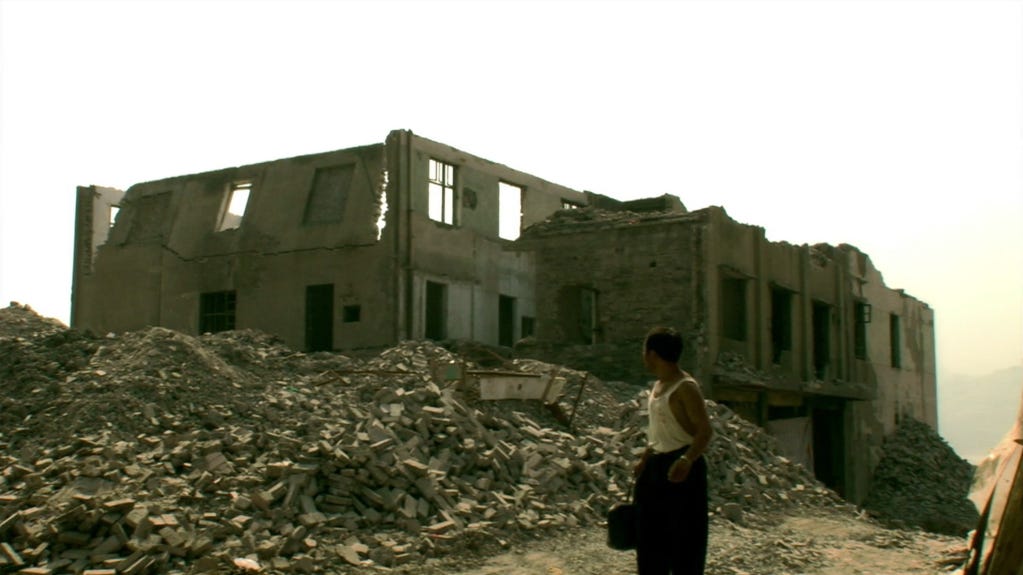I saw Caught by the Tides, Jia Zhangke’s latest film and I wrote about it here. When the theater I work at got the DCP delivered I made it my mission to get an off-hours screening of the film. Consider this my endorsement of being annoying in order to get what you want. I watched the movie a couple days ago and have been unable to stop thinking about it.
One thing to know about me is that, over the last 6 or so months, Jia Zhangke has become one of my guys. I’ve seen all of his narrative features, which is far from impressive - it’s about ten movies - but I am simply saying that I love his work and have sought his films out. Caught by the Tides is maybe his most experimental film to date, or second only to 24 City. A common criticism of Jia’s work is that he is unsubtle (true) and can take very big swings that don’t always hit (also true), it seems that this has turned a number of people off of his work but it’s what I find the most compelling about him. Mountains May Depart would not be the memorable and moving film it is if it didn’t have the insane English-language age gap romance 2025 section starring a character named Dollar.
Caught by the Tides is a pandemic film first and foremost. Much like his previous films Mountains May Depart and Ash Is Purest White, we follow Zhao Tao through three distinct time periods shot on a combination of different formats. What makes Tides stand out from those other two films, however, is that the bulk of this film is archival footage. The first two thirds seem, to me, to be constructed almost entirely of outtakes from 2002’s Unknown Pleasures, 2006’s Still Life, and 2018’s Ash Is Purest White. There’s a bit of documentary footage worked in as well as new footage. The actual pace and rhythm of these sections is less like a standard narrative film and more like what one would expect from a non-narrative experimental film. The sound design has an almost overbearing presence, there are so many songs and the soundtrack is consistently unpredictable. There are also lots of title cards, likely to smooth over dialogue that would not have made sense within this new film’s context, but it adds a layer of isolation. You hardly see Zhao Tao speak to anyone for most of this movie. You’ll see her walk around but dialogue or text messages will be delivered by words on a black screen. The animation from The World makes a brief reappearance! There’s a euphoric scene that looks to have been shot on some sort of camcorder where a man shows a massive, damaged portrait of Chairman Mao and tells the camera about his free opera that he operates. Zhao Tao hits the club! This is like ten christmases at once for a Jia Zhangke fan.
The first section, set in 2001, seems to be the heaviest on the documentary footage. Upon a first viewing it felt to me like the most abstract section, though that may have been that I was just so surprised to see footage from Unknown Pleasures. It sets an immense atmosphere with gritty digital footage and lots of singing.
The second section, set in 2006, sees Jia Zhangke once again revisit the Three Gorges Dam, the primary setting for Still Life and the middle portion of Ash Is Purest White. My one complaint with Ash when I first saw it was that the middle felt like a retread of Still Life (my favorite film of his), but now I think I may need to reconsider that opinion because I loved returning to the Three Gorges this time around. The way he mixes the outtakes from these two films is fascinating, Still Life’s digital and Ash’s 35mm rub against one another in a beautiful way. The scenes following Bin, played by Jia Zhangke regular Li Zhubin, reveal an entire subplot that was seemingly cut from Still Life. These scenes are fully acted out with dialogue that seemingly was shot back in 2006, it’s amazing. The scenes with Zhao Tao feel more isolated and collage-like, which is appropriate given she spends this chunk of the film looking for Bin. I remembered while watching this section the moment in Still Life where a statue reveals itself to be a spaceship and flies away in the background of a shot. It’s magical touches like this that make Jia Zhangke such a special filmmaker.
The third section of the film takes place in 2022. It has a distinctly ugly digital sheen to it and is in an almost IMAX aspect ratio. It is a reminder of Jia’s incredible ability to capture what a time period looks like. He has been one of the cinema’s great documenters of aesthetic change over the last 25 years. He has shot in seemingly all formats, using digital video and celluloid and 4K digital for different purposes. The 2020s have seen an immense amount of ugly 4K films, Tik Toks, and drone shots; you’ll find all of those in this final section. If you want to see Li Zhubin meet an influencer and Zhao Tao hang out with a robot then you will be in heaven. This section is humorous and sad in equal measure, but it’s also life-affirming. That Jia Zhangke is showing us people in masks struggling to connect like they once did is far from mind-blowing on its own, though it is interesting seeing how much more strict China’s COVID regulations were than in the United States, but this section gains an immense power because of what has come before it. There’s a sense of joy and freedom breaking out from behind these pandemic related restrictions. You can feel a filmmaker who is overjoyed that they get to shoot a film again.
The first two sections see Jia Zhangke repurpose old footage in order to tell a new story, which I read as him trying to make a film during the pandemic by any means he could. The final section coming after that then feels like the perfect conclusion to this collage. We can make films again, we’re breaking out of this pandemic, we are relearning how to connect with one another. I’ve largely disliked art about the pandemic because of how trite this message can feel, but Caught by the Tides feels like discovering fire.
This is without question one of my favorite films released in this decade so far.
I know this post is a bit disorganized, I’m kinda tired today - but you just gotta keep writing. If you’re still here, thanks for reading! It means a lot that you’d take the time to read my thoughts on a movie.







